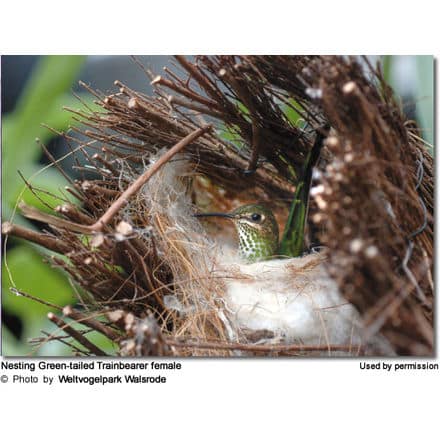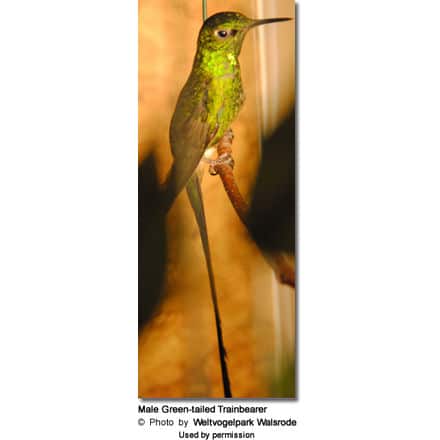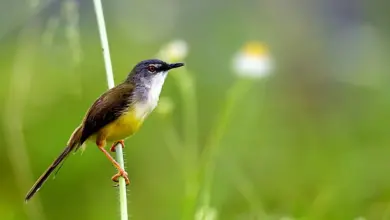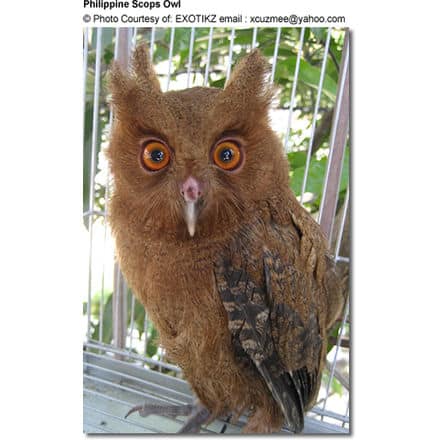Green-tailed Trainbearers (Lesbia nuna)
The Green-tailed Trainbearers (Lesbia nuna) – also known as Little Long-tailed Sylphs – are hummingbirds found in western South America, specifically the following countries: Bolivia, Colombia, Ecuador, Peru and Venezuela.
They inhabit subtropical or tropical moist montanes, high-altitude shrubland, as well as heavily degraded former forest, as wel as in parks, bush-filled pastures and areas with hedges. They occur at elevations from 5,600 – 12,500 feet (1,700 – 3,800 meters). At higher elevations, their range overlaps with the related, larger Black-tailed Trainbearer (Lesbia victoriae).
Their preferred habitats are subtropical and tropical heavily degraded former forest and shrubland; and to a lesser extent subtropical and tropical montane moist forest and high altitude grassland.
These active hummingbirds are resident (non-migratory) throughout their range. They are often seen hovering at flowers at various heights.
Subspecies and Distribution:
- Lesbia nuna nuna (Lesson, 1832)
- Found in the Andes mountain range of of southwestern Peru and northern Bolivia.
- Lesbia nuna gouldii (Loddiges, 1832)
- Weller and Schuchmann (2004) submitted a proposal to the South American Check-list Committee to separate this into its own species
- Found in the Andes of northeastern and south central Colombia. Previously occurred in Venezuela (Mérida).
- Lesbia nuna gracilis (Gould, 1846)
- Found in the Andes of Ecuador.
- Lesbia nuna pallidiventris (Simon, 1902)
- Found in the Andes of northern Peru.
- Lesbia nuna eucharis (Bourcier and Mulsant, 1848)
- Found in the mountains near Huánuco in central Peru. Formerly thought to have come from Colombia.
- [Lesbia nuna chlorura – Gould, 1871] – Proposed race – synonym of ssp. eucharis
- [Lesbia nuna boliviana, Boucard, 1891) – Proposed race – synonym of nominate race
Alternate (Global) Names
Chinese: ????? … Czech: Sylfa zelenoocasá … Danish: Grønhalet Slæbbærer … Dutch: Groenstaartkomeetkolibrie, Groenstaart-komeetkolibrie … Finnish: Pikkulaahuskolibri … French: Colibri à traîne verte, Colibri nouna, Porte-traîne nouna … German: Grünschwanzlesbia, Grünschwanz-Lesbia, Grünschwanzsylphe … Italian: Lesbia codaverde, Paggetto codaverde … Japanese: komidorifutaohachidori … Norwegian: Grønnslepkolibri … Polish: pazik zielonosterny … Russian: ????????????? ?????? … Slovak: chvostá?ik vle?kochvostý, vleckochvost zelenochvostý … Spanish: Colibrí Colilargo Menor, Colibrí Coludo Verde, Cometa Coliverde … Swedish: Grönstjärtad släpsylf
Hummingbird Resources
- Hummingbird Information
- Hummingbird Amazing Facts
- Attracting Hummingbirds to Your Garden
- Hummingbird Species
- Feeding Hummingbirds
Description
The male Black-tailed Trainbearer averages 16 – 19 cm (6.25 – 7.5 inches) in length. The female is a little smaller – she is only about 10 – 12.5 cm (4 – 5 inches) long.
Only the male has a long, forked tail that makes up most of his length – the tail alone is about 10 – 12 cm (4 – 4.7 inches) long.
Both the male and female have a mostly green plumage. The male can be identified his forked, long tail, and the female’s underside is white with extensive green spotting.

Nesting / Breeding
Hummingbirds are solitary in all aspects of life other than breeding; and the male’s only involvement in the reproductive process is the actual mating with the female. They neither live nor migrate in flocks; and there is no pair bond for this species.

Males court females by flying in a u-shaped pattern in front of them. During these courtship displays, male Green-tailed Trainbearers make snapping sounds with their tails.
He will separate from the female immediately after copulation. One male may mate with several females. In all likelihood, the female will also mate with several males. The males do not participate in choosing the nest location, building the nest or raising the chicks.
The female Green-tailed Trainbearer is responsible for building the cup-shaped nest out of plant fibers woven together and green moss on the outside for camouflage in a protected location in a shrub, bush or tree. She lines the nest with soft plant fibers, animal hair and feather down, and strengthens the structure with spider webbing and other sticky material, giving it an elastic quality to allow it to stretch to double its size as the chicks grow and need more room. The nest is typically found on a low, skinny horizontal perch.
The average clutch consists of two white eggs, which she incubates alone, while the male defends his territory and the flowers he feeds on. The young are born blind, immobile and without any down.
The female alone protects and feeds the chicks with regurgitated food (mostly partially-digested insects since nectar is an insufficient source of protein for the growing chicks). The female pushes the food down the chicks’ throats with her long bill directly into their stomachs.
As is the case with other hummingbird species, the chicks are brooded only the first week or two, and left alone even on cooler nights after about 12 days – probably due to the small nest size. The chicks leave the nest when they are about 20 days old.
Diet / Feeding
The Green-tailed Trainbearers primarily feed on nectar taken from a variety of brightly colored, scented small flowers of trees, herbs, shrubs and epiphytes.



